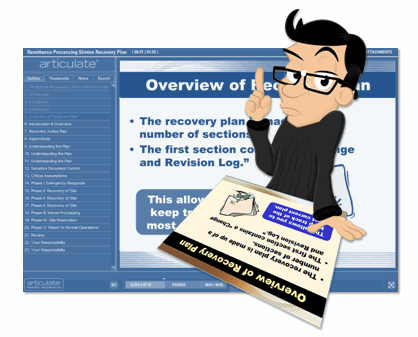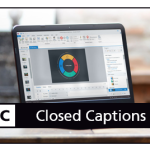Interesting post Tom,
we tested a lot wether to have or have not music in our math levels. Turns out that just instrumental music that is not too loud does have a positve effect on the kids we tested it with. They started answering the math questions to that particular beat, or even began to do “freestyle”-hiphop math.
Also audio files like “great job”, or “fantastic” are in fact enhancing their will to learn more. Parents say the same when learning together with their kids.
Overall they could concentrate better, where higher motivated to learn their math and, most importantly, they learned better!
As long as there is a “mute” button, I think that well put music & audio-files contribute to a better learning effect.
Should You Add Background Audio to Your E-Learning Courses?
December 1st, 2009I get a lot of questions about whether or not to add background music to elearning courses. That’s like answering whether or not you should put a blue square in your course. If the blue square makes it a better course, “Yes.” If not, then get rid of the square. The same is true for background audio. It all depends on the context.
Instructional Design 101

Instructional design is about crafting a learning environment to meet specific objectives. Nothing in your course should be accidental or haphazard. All elements that make up the course should be intentional. In that sense you need to ask if the audio you are using will add to or detract from the learning objectives.
When does Audio Detract from the Learning?
Some people like to add background audio to their courses because they know that by itself the course content is somewhat boring. So adding some background audio will jazz it up a bit and makes the course exciting and inviting.
Guess what? If the course is boring, adding audio will only make it boring and danceable. You’re best served to spend your time designing the right type of course and spending less time looking for ways to “jazz it up.”

The course’s goal is to help your learner learn. So when you add audio to the course it should contribute to the learning. In a previous post, I shared a little about cognitive load and how to get your learners to remember more. If the audio doesn’t help, then it offers little value; or worst case, it actually diminishes the value.
- Background audio might impact your working memory. Background audio might conflict with other information. Adding too much information at once might overload the brain’s processing. This impacts how well the learner can recall the information in the course. It probably makes sense to skip this type of audio on crucial learning segments where retention is critical.
- Multiple audio tracks can impact retention. Some studies suggest that combining narration, ambient audio, and background music can impact retention. This makes sense because you’re giving the brain a lot of audio information to process at the same time.
- Narration and background audio aren’t the same things. With narration the risk is that you are sharing information that competes with information that the learner is processing visually. Background audio is not the same since it has no informative value. My guess is that the brain quickly learns to filter it, the same why I do to my kids when I watch boxing. That’s why I wouldn’t get too dogmatic about background audio in all circumstances.
Your ultimate goal is to craft the best learning experience. If the audio adds no value, you’re probably better off getting rid of it than adding it to the course. With that said, some courses are only designed to share information. In those cases, you could probably be a little more liberal in your use of audio than if your goals are real retention and improved performance. In either case, it should not detract from the course content.
When Does Audio Add Value?
Multimedia learning is relatively new and the way we craft elearning is changing. We have everything from the standard page turners to immersive learning games and activities. Because of this, the principles aren’t always the same. What you might apply to a static page with text and narration isn’t going to be the same for a much more interactive activity where retention is more critical.
- Ambient audio contributes to an immersive experience. A role playing scenario is different than specific, step-by-step instructions. In that case, there’s probably some value in using audio to create a more immersive experience. Think of setting the scene where someone is working in a hurried environment with a lot going on…like an emergency room. The proper use of audio and visual design can contribute to creating the right type of situation and context.
- Background audio can create emotional cues. Think of a movie like Jaws. Probably the most memorable part of Jaws is the sound track. In some ways it acted as a narrator. The music kept us at the edge of our seats, telling us, “Be careful, there’s something coming.” There’s no reason why elearning courses can’t employ a similar use of background audio to provide some emotional cues and hooks.
- Music can contribute to changed behavior. There are some studies that suggest certain types of music at set beats per minute can influence how the brain receives information. Perhaps there’s some value in adding a baroque audio track to certain types of elearning courses. Here’s a site with some links if you want to read more about music and the brain.
How are other industries using audio? I already mentioned the movie industry as an example. But you can also glean some ideas from the gaming industry or multimedia news and documentaries. I like the audio slide shows that the New York Times produces.
Click here to view the New York Times demo.
This one starts with a door slam. It pulls you right in and sets the stage. Then listen to some of the ambient background audio. While it’s subtle, it all adds to the emotional value of the piece because it puts you there. Without the ambient audio, it would lose some of the emotional edge and be a much more sterile and probably less personal piece.
The same is true for your elearning course. There are some courses and topics that can benefit from good ambient or background audio. Next time you’re doing analysis and meeting with learners, stop and listen to what it sounds like where they work. Is there a way you can bring that sound into your course?
Things to Consider
There’s so much variety to elearning and the types of courses that are produced it’s hard to be dogmatic about when and where to use background a
udio. The main point is less about the audio and more about your intention. Once you know what you want to do, then you decide when and where audio fits in.
- Each element of the course should contribute to the learning. Don’t add audio for the sake of audio. Everything you add to the course from the multimedia content to the activities should exist to satisfy the learning objectives.
- Keep the content relevant. The more relevant the content is to the learner, the more apt they are to pay attention. When it’s not relevant, no amount of background music will “jazz it up.”
- People are complex. While cognitive load theory is an important consideration in course design, we need to be careful not to be too dogmatic about its application. The brain is complex and sometimes the cognitive load discussion seems to be too simple and applied with a broad brush. Like all learning theories, they’ll be refined over time. I see them more as considerations and principles to guide design and less as steadfast rules.
I like the story Malcolm Gladwell tells of the early days of Sesame Street in the Birth of Big Bird. The scientific advisors (probably steeped in sound research) warned against mixing fantasy and reality. If the founders had gone with that advice, the show would have died. Instead, they did mix them and the show proved successful.
There’s probably a lesson in there for us. To learn more about multimedia in elearning and the effective use of audio, it might help to step away from the elearning industry and look at other disciplines that use multimedia, like the advertising, gaming, and movie industries. What can we learn from them?
I’d love to hear how you’re using audio in your courses. Got any tips and tricks? Feel free to share them by clicking on the comments link.
Events
- Everyday. Check out the weekly training webinars to learn more about Rise, Storyline, and instructional design.
Free E-Learning Resources
 |
 |
 |
|
Want to learn more? Check out these articles and free resources in the community. |
Here’s a great job board for e-learning, instructional design, and training jobs |
Participate in the weekly e-learning challenges to sharpen your skills |
 |
 |
 |
|
Get your free PowerPoint templates and free graphics & stock images. |
Lots of cool e-learning examples to check out and find inspiration. |
Getting Started? This e-learning 101 series and the free e-books will help. |
41 responses to “Should You Add Background Audio to Your E-Learning Courses?”
Missed you last week, Tom. Hope you had a nice Thanksgiving.
In one e-learning course, for nurse practitioners, we needed to demonstrate a nurse practitioner’s professional behavior during a patient consult.
Tone of voice, words chosen and used, and posture were important learning objectives. To model these, we created a module with a series of professional photos that covered the entire content stage. We overlaid each still photo with the “actors” voice-over narrations. (Three “actors”: Nurse practitioner, patient, and patient’s loved one.)
I can’t wait to read other examples from your community of blog readers.
@jenisecook
Good post Tom. I’ve personally not seen much eLearning with background music (very little, actually), but frankly, a “good beat you can dance to” would be a welcome addition to a lot of the mind-numbing stuff I see. Not that it would necessarily enhance learning, but it certainly would kill the dull. And maybe killing the dull with background music isn’t such a bad idea in some cases.
Of course that’s saying more about bad eLearning than it is about using background music.
Though I don’t think background music would be effective for *most* eLearning applications, I would certainly like to see it used more often (in effective ways, of course).
Lots of research to show how ambient music can increase retention in learning interactions…
But I’d always give learn option to turn music on/off for duration of course. If time/money wasn’t an issue, developers could give learner option to change types of ambient music in the course, perhaps even port through to their Pandora or iTunes preferences. I’m sure our Exec. leadership wouldn’t mind funding that capability (ha ha).
Thanks for all your posts. I’ve learned so much through your articles.
s.c.
I have used background music as a lead in and transition out of scenarios. It has proved pretty effective in that limited role!
Tom
Tom, excellent take on the use of audio. I’ve had these discussions with colleagues a number of times. It’s nice that now I can send them this article to refer to.
The biggest issue I run into is not so much with background audio but with narration. SME’s want to have the narration saying something other than what the user is getting from the screen which I beleive causes a great deal of conflict with what the brain will have to process thus taking away from the overall learnign experience.
Once again you’ve provided great information.
Thanks Tom!
I’ve been thinking about adding low volume classical music to the reflective exercises I am asked to include in the courses I create. I’ve heard classical music, especially baroque can actually aid learning so I thought I’d give it a go.
The New York Times demo is amazing – I was totally engaged for the duration – it combined story telling, relevant and attention grabbing images and ambient sounds that combined, gave a much more immersive experience. I will try to remember it when I am working on my courses – thank you!
I usually add music to my courses for 2 reasons–one creative and one practical:
1. I do mostly product/sales training for a sales audience. To build excitement I try to make my e-learning courses like interactive commercials. I do think music adds to atmosphere I’m going for.
2. I do my own narration, and it’s usually pretty quick & dirty. I can’t always clean up the audio to perfection. The background music helps mask any pops, clicks, and audible edits in the narration track. It’s a choice: which is more distracting to the learner? An imperfect narration track or some quiet background music? In an ideal world I wouldn’t have to make that choice, but in the real world we have to do whatever it takes.
THANK YOU! I’ve been looking for guidance on this.
And this comes at JUST the right time. I’m supposed to complete some movies today!
We recently added audio to a new product intro elearning course. But the course intro / welcome slide still sounded horribly dry. We laid down a subtle music background along with the welcome audio, and it immediately sounded far more professional and polished. It fades out after about 20 seconds.
I’m no expert, but the music adds something warm and intangible, like someone saying hello and smiling. Maybe this expectation comes from TV and movies? But without it, the intro seemed jarringly empty.
Thanks for the great info! This is a somewhat mysterious subject that I rarely see discussed.
I have created a mixed media activity using Articulate Presenter, a movie I have created (from other peoples stuff) and a branching scenario (got that idea from a previous post) to create an activity on “Affecting Obesity”.
I used the video and the music to transition between the delivery factual information and options for a solution providing feedback for each option. I wanted to take the serious, inject a little humor, and segwe back into the activity with solutions to the dilemma of the factual information.
Although it has not been formally delivered, it has been received with positive response. I do see some small changes that need to be made.
Could any one advice on where to find copyright free music that could be added in e-learning modules?
Thank you!
There are some additional considerations for background audio:
1) The quality of the audio. No background audio is better than bad audio – static, volume within/between modules or in comparison to voiceover
2) Bandwidth – does it affect remote learners
3) “Busy-ness” – there are some brain studies that show that female and male brains filter/focus sound differently…which might be why might be able to more effectively filter out kid noises during boxing on TV. Here is a link to an interesting article that references the study I was thinking of
http://techrepublic.com.com/5208-12850-0.html?forumID=102&threadID=320703&messageID=3200594
Search for the part that includes the words “tape players”
Personally, I like Steve C’s suggestion of picking preferred music.
Julien,
I have found some useful music and sound effects at Flashkit.
http://www.flashkit.com (for loops – http://www.flashkit.com/loops/). Some are copyright free others are not, so read the notes carefully. These are especially good if working with Flash projects, but not limited to Flash since they are usually MP3 and WAV files.
In response to the post, aside from narration for sims, I usually avoid audio. However, if a course is presented as an animated story, I have found audio to add value, similar to a film’s soundtrack.
Thanks Tom for the excellent choice of topic
My problem is with narration and localization, as it brings the need for either subtitles or a whole new voice-over.
Articulate notes are a good way to see a localized narration but I was wondering if there are any guidance on, how much narration is truly needed for a e-learning?
You should also check out http://www.flashkit.com/loops/. They have thousands of royalty free music files. I’ve used them as background for some podcasting and training videos I’ve done.
Hi Everyone: I design ILT and WBT training programs for hospital workers. I had not used audio extensively in our e-learning programs because many of the PCs in the clinical areas do not have speakers. We did one program last year, “Code Management,” which moved a one hour, annual, ILT training addressing the role of RNs during a Code Blue, to a 25 minute on-line course. And, yes, I added a sound clip from Saturday Night Fever’s “Stayin Alive.” (This tune has become the American Heart Association’s CPR song because it has 103 beats/minute….the recommended rate of chest compressions in CPR.) The nurses loved it. At first, they just thought it was cute, but then they got it!
So, thanks for addressing the issue of audio and how it can be an effective tool when used in conjuction with good training design.
This may be at a bit of a tangent to the main topic in question, but since it was raised by Marc above, and Tom, can I just pipe up about narration. Tom makes an excellent point distinguishing narration from background audio (or din, as some might label it), and it bears repeating…
“Narration and background audio aren’t the same things. With narration the risk is that you are sharing information that competes with information that the learner is processing visually. Background audio is not the same since it has no informative value…” [though background audio can, as Tom says, enhance emotional, immersive and other behavioural aspects of the learning experience.]
All too often, narration seems be viewed by developers as de rigeur, (the dreaded “throw it in because you can” approach to elearning) and an instructional designer worthy of the name should always call it into question. That doesn’t necessarily mean rejecting it, but it does mean a rule of thumb to include it if and only if there is good instructional reason to, not the converse. My own approach is to have the option of narration (for accessibility purposes), but to make it a deliberate act on the part of the user to enable it.
Another point on narration if you are to include it: it is always preferable (and this doesn’t take vast extra resources) for the narration to be an adapted version of the onscreen script and not an exact mimic of it. Yet how often do we see courses where the narration plods along dictating word-for-word the onscreen text? What a big yawn. My own observation of users (learners, testers, developers, myself!) is that when narration is an exact replica of onscreen text, the eyes glaze over and the attention starts to wander – the reading and the listening processes seem somehow to interfere in a mind-numbing way. There are sound psychological reasons for this and it goes back exactly to Tom’s point – instead of complementing each other, the visual and auditory learning processes are competing with each other.
A good content writer or editor will always be able to trim and remould the narration to suit the spoken and heard medium. And there’s nothing wrong with pauses and cadence, by the way! Also, where narration must be provided, it helps to make the default when narration is selected that onscreen text be disabled. If the user really wants both up, it should be a conscious act of selection. Better still, to return to the first point, no narration, without a good argument for including it.
Bruce
And if I may stray into the central topic here, of background audio.
If background audio is to be provided (whether music or sound effects), it should always be remembered what every good radio producer knows – that the spoken word should never, never, never be compromised by background noise. There are a great many hearing-impaired people around, including many tinnitus sufferers, who already have their very own background noise to contend with. You must hear (perhaps you already have) how angry they get about poor-quality radio programmes where supporting music impinges on the talking.
And quite right too. You wouldn’t print black type on a dark-gray paper and expect respect from the sight-impaired. So too in our courses… when the voice is actually speaking, whether narration or scenario actor – no background sound!
Bruce
I’ve used music in a couple eLearning pieces I’ve built. I did so sparingly: intro & out. My purpose was for emotional augmentation. One was an abuse/neglect training. For that I chose music that was a bit strident and staccato appropriate to the subject. The other was a customer service piece. For that the mood desired was quite the opposite so I chose a familiar baroque piece with gentle, smooth notes. They have been well-received. (And our customer service scores have been going up. Can I claim sole credit? Doubtful but the eLearning contributed.)
–Allen
@ Tom – yet another fabulous post, I think you put it succinctly
@ Bruce and Tom – I agree Narration and Audio Background are two different things. However, I do see a third option to Bruce’s suggestions where Narration is provided – and key words are presented only (just like a good facilitation of a well-designed PowerPoint – I stress well-designed!!)
In my previous firm – a large multinational archictectural firm – the values module showed images and videos were set to an instrumental version of Love Will Tear Us Apart. It was an incredibly emotional way to explain the company’s values and share a sense of belonging. The reason why it worked so well is that is was well designed and all elements had a purpose and it was focussed. During the module, when the managing directors speak – the music was faded out. The whole module itself had no interactivity – but was incredibly engaging. The stats showed it was watched multiple times by many staff (even those who had been with the company for a long time). Now that’s powerful stuff.
Tom, this is a powerful and often contentious topic. You are right that the studies recommend against audio that does not contribute to information, which by definition would include music. I agree that it should only be a guideline, however.
I went to look at the link you provided about “music can contribute to changed behavior.” I looked at about five of the papers on the list. I was shocked at how poorly written they were, and how juvenile they seemed. Is there anything more credible about the brain/music link?
Just your article, and the posts of other folks, have given me some great ideas for improving my e-learning.
Thanks, Heidi
Tom, this is a standout post! Thanks for discussing adding background audio into eLearning.
My dissertation is on mixing modes of multimedia, learner choice and cognitive load. While research does suggest that pairing visual (images/video) and verbal (audio, e.g. narration/music/written text) information to assist with assimilation of content, ID professionals must be careful not to add to the cognitive load by including too many competing media. If your content is challenging it has an intrinsic cognitive load. By adding too much additional media, the extraneous load is also increased making it even more difficult for learners to assimilate and retain the information they need to know. As ID professionals, keeping it as simple as possible and providing engaging learning is a balancing act we do each time we create multimedia learning experiences.
An earlier comment pointed out that adding audio increases file size and hence bandwidth issues. Much of the audio we use is natively stereo, and by changing it to mono the file size can be cut quite a bit. Unless it is critical that your audio be stereo, mono will do just fine.
-Debra
Tom, not only was this helpful (as usual), the example you chose to illustrate your point was excellent. Yes, an image is worth a thousand words but add the spoken word and you can create a big IMPACT.
[…] (VP of Community) published a blog post on effective uses of audio in e-learning courses. His post is about using background audio, or ambient sounds, and he included this great example from the New York […]
Here is a simplified guide to put BG audio in context. According to the audio engineer I had in film school:
1. Dialogue tells the story.
2. Sound effects (natural and man made) create a sense of reality.
3. Music creates an emotional response.
The trick is to know how to coordinate and balance the audio with the visuals to produce the desired affect.
Cheers, RAW
@Debra – that’s a good point about file size. When audio is used for ambient purposes, it’s often ok to use a lower bit rate to reduce file size. Save the higher quality sizes for narration and drop the ambient down a bit.
Do you have any articles or blogs regarding your ongoing research? I’m sure many of us would be interested to follow your research.
David
Articulate
OK I’m straying off of Tom’s topic a bit, but I have some issues about narration versus no narration. And this is not just eLearning, but plain old in-person Powerpoint as well.
I agree that narration can conflict with onscreen text. Studies have shown that when the viewer tries to comprehend both simultaneously, overall comprehension suffers. Overall comprehension actually improves when the narration really does match the on-screen text, word for word. But that’s stupid. Which mean you should do away with one, or the other.
But let’s compare the two. On-screen text has some variation. There’s different fonts. Different sizes. Bold. Italics. Change the color. All caps if you want to scream. But that’s kind of it.
Narration – the real human voice, not the text-to-speech kind – has an infinite range of inflections, volumes, fast, slow, stressed, relaxed; and let’s not forget silence and pregnant pauses. These things can convey a wealth of information that just isn’t possible in on-screen text. In fact, the on-screen text is just about as lifeless as that text-to-speech stuff. So narration wins, hands down, in my book. Besides, if you chose to do away with the narration, then you may as well publish a book. Why even bother with multimedia eLearning?
So do away with the on-screen text. Use imagery to support your narration in stead of verbosity to compete with it. A picture really does say a thousand words. And these two forms of information are something that the human mind can deal with simultaneously.
Powerpoint is a good tool, but it’s too often misused. The default is bullet point, bullet point, bullet point, bullet point. And most people fall right into that pattern. When I create Powerpoint, whether for in-person presentations or to later publish in Articulate, I always start with blank screens. And if I must have text, I limit it to two or three words presented at a time. That’s something the mind can handle at the same time as your narration.
Music, because of its specific and far-reaching metaphorical powers, can name the unnamable and communicate the unknowable.
-Leonard Bernstein, “The Unanswered Question” p. 140, 1976
Done right, music can transform the experience. But, as we all have experienced the poor results of PowerPoint in the hands of amateurs, music will probably be poorly executed and eLearning will get another black eye.
Beware the Jabberwock…
Doug
About narration:
The first course I have made was a great text&flash animation & video etc for medical sales. The second one was like a PPT with narration. Like an mbook, I would say today. To my surprise, sales reps preferred the 2nd. When I asked, why (a little bit disappointed – there was lot of energy invested into #1), they explained that the narrator gives a living example of the interpretation of the scientific knowledge, they can follow her building up their own interpretation.
Regarding royalty-free clips, you can find a lot of great stuff included with recorders/editors such as Apple’s GarageBand and Adobe SoundBooth. You can mix, match slice and dice musical parts to create a clip of exactly the duration you need. It’s easier than you think and actually quite fun.
We do a lot of audio fpr elearning. Sometimes it is better just to have a plain voice, it depends on the product and viewer. But Wsound” it is one of the mostly underestimated things in elearning…
Good post. This was very helpful and informative. I am an Instructional Technology graduate student at Bloomsburg University. Currently I am in the process of creating a learning program for radiology students on the anatomy of the shoulder. This article gives me some insight on the pros and cons of audio used in e-learning courses. As of right now, we are leaning on not using background music. Our lesson will be identification of the shoulder using images and x-rays. In this circumstance, I believe it will distract the learner. If any music would be used in a circumstance like ours, only use it in the intro and possibly at the end. This way it won’t distract the learner during the main part of the course.
I have participated in some e-learning courses in the past that had background music. In some instances, I found it to be distracting, rather than adding benefit. Like you said, sometimes the creator adds music in hopes of jazzing up the course. If music is inserted just for the sake of just adding music without a direct correlation to the content, it’s doing more harm than good. If background music is inserted into the course, I would prefer having the ability to turn it off. I know I could just turn the volume down, but sometimes there is narration along with the content.
Background music does work well with interactive courses. Like you said, background audio can create an immersive experience. In these instances, background music gets me more in the “zone” when I am in an interactive course, especially if the music changes when you click on a certain object or get to a certain point.
[…] […]
[…] that they’re having fun when the course itself could put an actuary to sleep. As Tom Kulhmann wrote a couple of years ago, “If the course is boring, adding [background] audio will only make it […]










0
comments